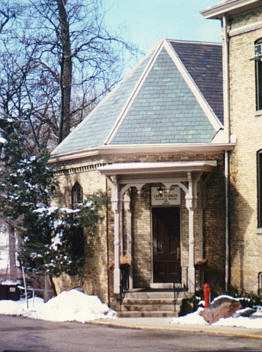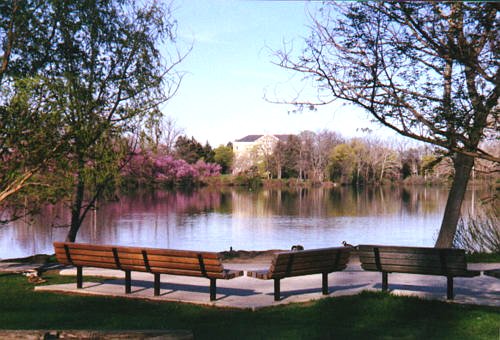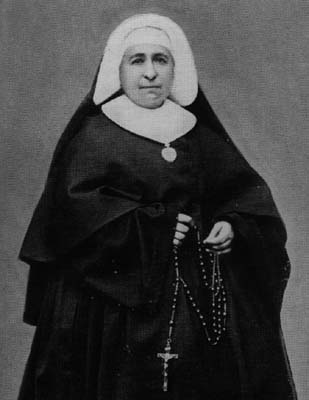
Notre Dame's Grotto / by Dorothy V. Corson

Sister Lourdes and Sister Bernadette at Notre Dame
Two Sisters of the Holy Cross, Sister Lourdes and Sister Bernadette, spent most of their religious lives on the Notre Dame campus. For 59 years Sister Bernadette baked the altar breads and cut them for the chapels. Sister Lourdes worked in the kitchen at Carroll Hall for 62 years. Their names and the dedicated lives they led marked them to be included in the story behind the Grotto.
Sister Lourdes arrived at Notre Dame in 1874, the same year the first Grotto was built in Lourdes Hall. A description of her life and death on campus could have been written about Saint Bernadette, who lived the same very simple life of service. She spent most of her life going between old Carroll Hall in the Main Building and the convent chapel, pictured below, a distance of less than 100 feet.
Her devotion to Notre Dame was remembered in the 1936 Notre Dame Alumnus : "Sister Lourdes dies at 85."

Death on January 12 touched lightly a noble soul, revered in the memory of thousands of Notre Dame men the world over -- Sister Lourdes, C.S.C., 85 years old, the "coffee urn Sister" of the old kitchen. Her story is a simple one. . . . She had spent her entire religious life at Notre Dame. In that time she left the campus only two or three times. She set herself to do one thing humbly and generously -- to please God in every thought and word and act. She was assigned to try to please God in the Notre Dame kitchen. Thousands of Notre Dame men, priests, brothers, professors and students -- in every part of the world rise up and call her blessed. Sweetness and kindness itself, she knew only two places in her long life, one was the kitchen near Carroll Hall where her motherly heart and lovely smile dispensed buns and soup and a "handout" to countless minims and juniors and seniors and the other was the convent chapel.
She did only one thing; she pleased God and Him alone. Only the immortal Father John W. Cavanaugh, who preceded her to Heaven could adequately describe this valiant Notre Dame woman:
To the priests who attended her in her last illness, it seems more fitting to ask the students to pray to her than for her. For 72 hours she lay dying and conscious till the very last. She was just pleasing God. Her only words were ones of thanks for His blessings. She did not have the shadow of even the least worry. If God wanted to take her in 11 seconds, all right; if He wanted her to linger on for 11 years more, all right. She died in Christ's peace with a smiling good-bye to Notre Dame.
May her powerful prayers [and those at the Grotto, her namesake] help Notre Dame and the sons of Notre Dame do the one thing necessary -- to please God in every thing.(112)
Carroll Hall in the west wing of the 1879 Main Building was named after Charles Carroll (1737-1815), the only Catholic and the last surviving signer of the Declaration of Independence. His cousin, Bishop John Carroll (1735-1815), the first Roman Catholic bishop in the United States, ordained Rev. Stephen Theodore Badin, the first priest ordained in the United States. It was Fr. Badin who organized the Mission and Indian Orphanage at Ste. Marie des Lacs -- the future home of Notre Dame.
Sorin had a great admiration for America and its patriots and he honored them by naming halls on campus after them. Brownson and Carroll Halls, housed in the new Main Building, date back to the huge fire. For years the students of the university lived the common life of the dormitory -- dressing on the first floor, studying on the second and sleeping on the third.
In 1943, during the war years, Carroll Hall in the west wing and Brownson Hall in the east wing of the Main Building were vacated. When the Holy Cross Sisters who lived at Notre Dame went back to St. Mary's in 1958, Fr. Hesburgh carried on Sorin's tradition by renaming the building that had served as their convent Brownson Hall.
Later across St. Mary's Lake, Dujarie Institute, built as a Brothers' house of studies in 1906, was vacated by the Brothers when they established Holy Cross College. Its new name, Carroll Hall, was borrowed from old Carroll Hall in the Main Building. It became an undergraduate dorm in 1977 where, it was said, "its isolation from other campus dorms promoted camaraderie between students . . . and a real family atmosphere."

And so, old Carroll Hall -- the domain of Sister Lourdes, the "coffee urn Sister" -- still lives on in memory across St. Mary's Lake near Redbud Island. It is the focal point of this peaceful scene taken from the lakeside benches directly across the road from the path leading to the Grotto.
Sister Bernadette and Sister Lourdes were not alone in their devotion to their duties at Notre Dame. An account of the work of the Sisters at Notre Dame under the direction of Mother Ascension is mind boggling:
Mother Ascension was gifted with exceptional powers for organization. During her administration the convent at Notre Dame presented the efficiency and productiveness of a small factory. The amount of work accomplished is inconceivable. The Sisters did the baking and cooking for the whole institution. They set type, read proof, folded and sewed by hand the Ave Maria and the Notre Dame Scholastic . They cared for the poultry, milked the cows, and made butter and cheese. They tailored the suits, cassocks, and habits. They laundered and mended the clothing. They wove the table linen, manufactured mattresses and window shades, knit socks and underwear, made the vestments and baked altar bread for Notre Dame and the nearby missions.
Fr. Sorin's will was the will of God to her, and often she followed it at the cost of great personal sacrifice.
 At her funeral, Father Hudson's eulogy captured the essence of Mother Ascension's Christian dedication:
At her funeral, Father Hudson's eulogy captured the essence of Mother Ascension's Christian dedication:
All Christians direct their course to the same Divine End, yet each soul approaches God by its own uncharted path. To attempt to follow Mother Mary of the Ascension on her quest of God is to be lost in labyrinthine ways. Only of this can one feel confident, that at last, after many wanderings, she reached her heart's desire. . . . to the end she was devoted heart and soul to the interests of Notre Dame.(113)
In a pamphlet honoring the Sisters of the Holy Cross at Notre Dame, written at the time the convent was closed in 1958, more evidence of the Sisters devotion was cited:
Once, many years ago, when Father Matt Walsh was president, he was determined to show the Sisters that their services were highly appreciated. He approached their Superior and made known his desire to do something for the Sisters. What would they like? What could he do to show them that the priests were grateful for the part they were playing in Notre Dame's welfare?
The superior demurred, and said she would ask around among the Sisters for their opinion. When Father Walsh went back to find out their wishes, the superior said to him: "Father, most of our nuns never get outside very much. Hardly any of them have ever seen Lake Michigan. We thought a little outing up to the Lake might be a happy diversion. But we don't want to cause any . . . ."
Father Walsh told her that was just fine and they would arrange it to suit their convenience.
So one summer day, as many of the nuns as could be spared got into automobiles, some of them for the first time, and were driven off to the blue waters and refreshing breeze of Lake Michigan. Father Walsh, seeing how delighted they were, could only exclaim "What a very little thing they ask for all their months and years of service!"(114)
More than one priest has mentioned that Notre Dame would not have been here without the dedication and devotion of the Sisters of the Holy Cross at Notre Dame.
How appropriate that Notre Dame was blessed with a Sister Bernadette and a Sister Lourdes to grace the Grotto with their presence.